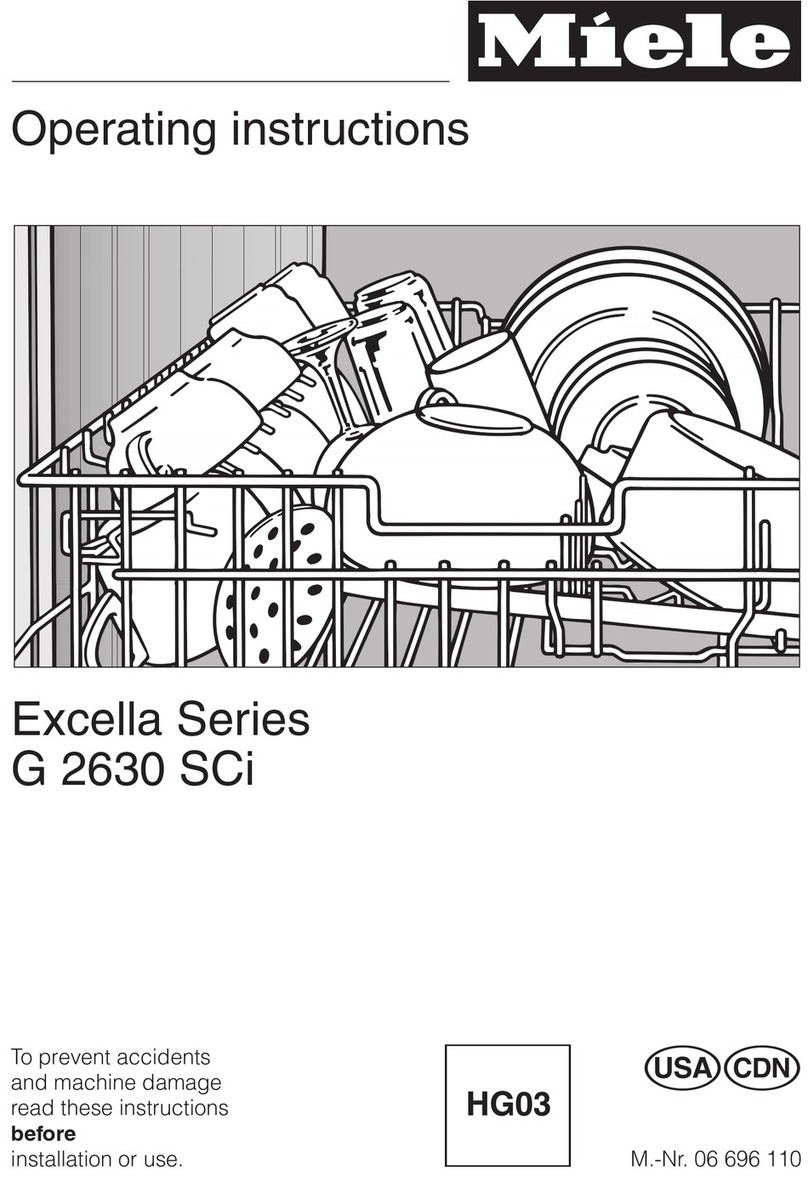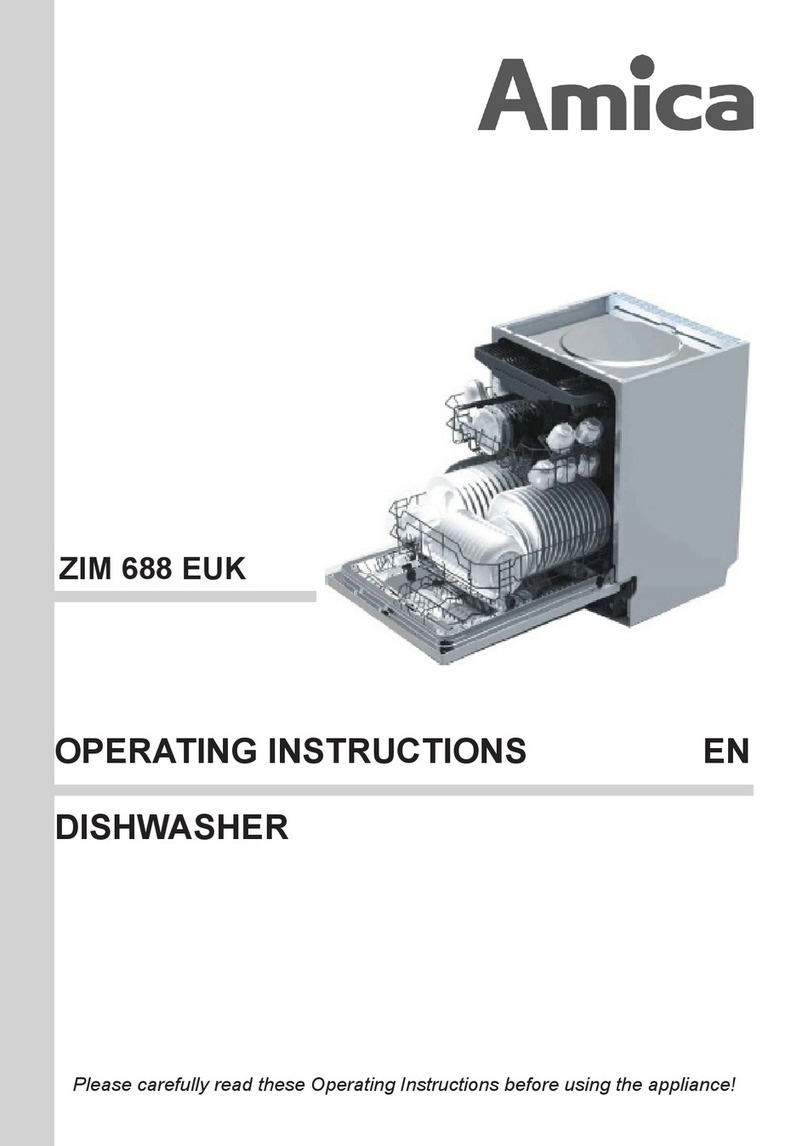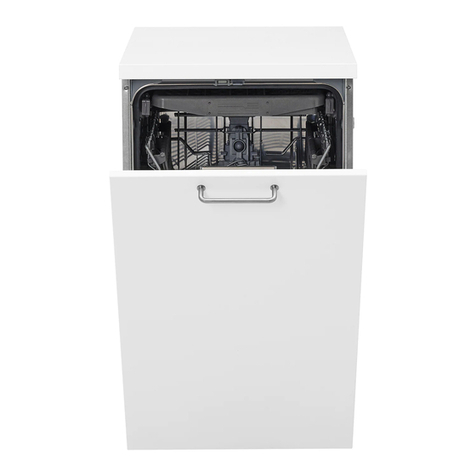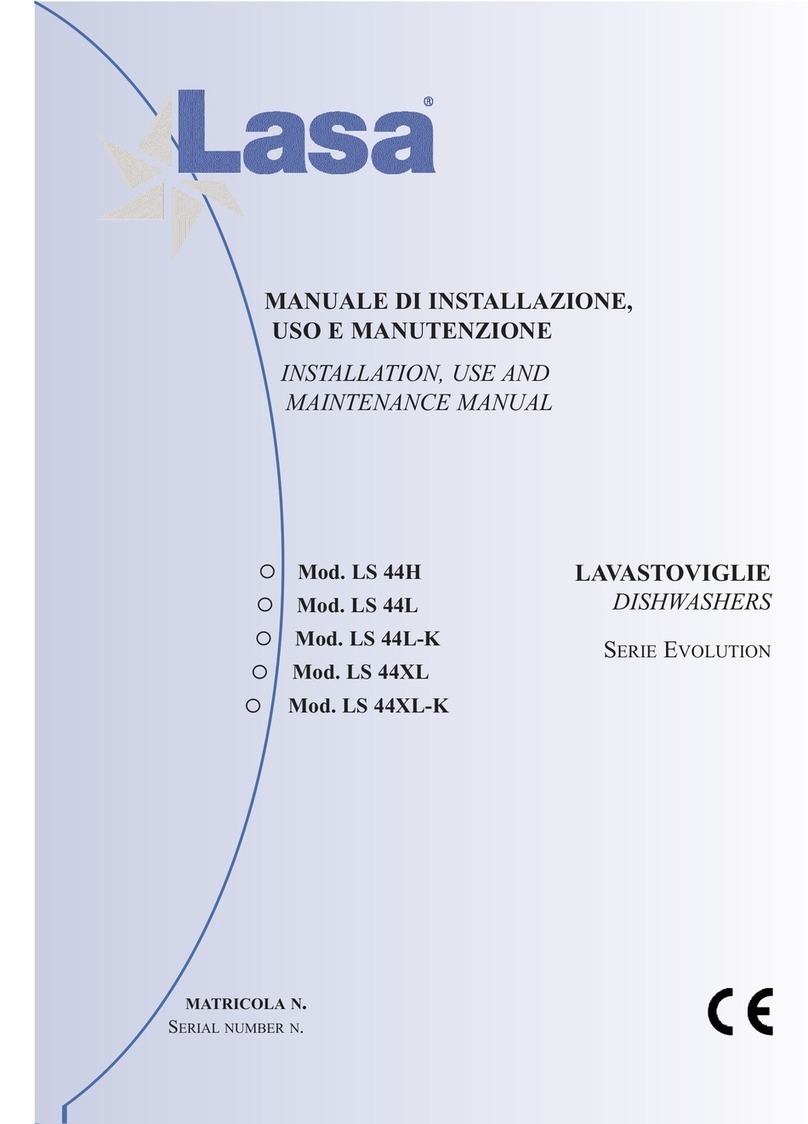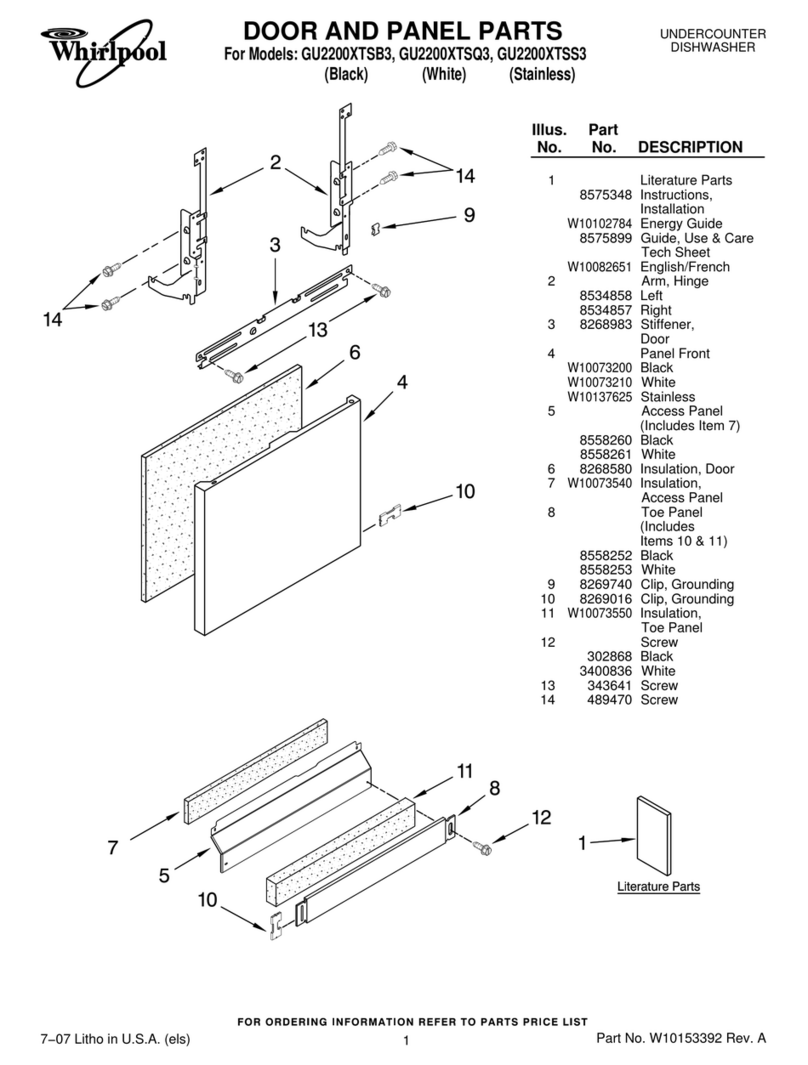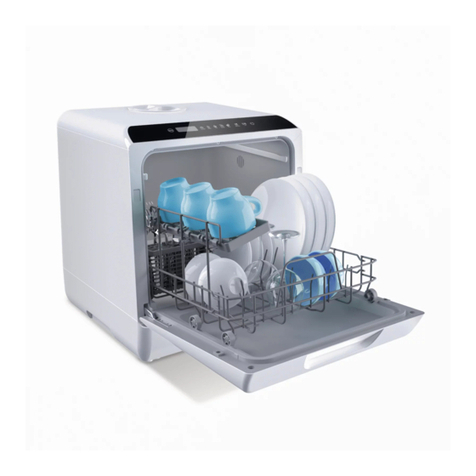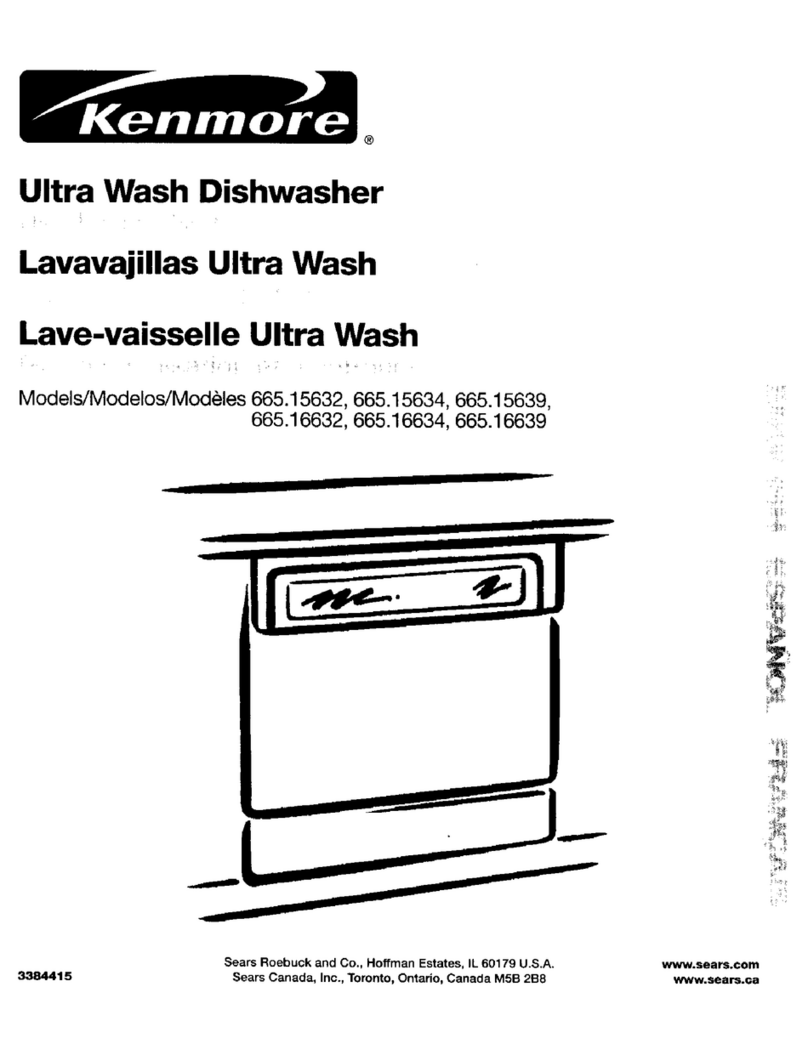Bellini BDW86S -F User guide

1
45cm Dishwasher
BDW86S
BDW86S -F
BDW86X
BDW86X -F
BDW86W
BDW86W -F
20130621 issue0
For warranty service call 1300 373 199 to
connect you to the nearest authorised
service centre

Compartment
Fill main-wash detergent.
Compartment
Fill pre-wash detergent.
(Follow the user instructions!)
Mechanical indicator
Check the rinse aid level
Load the baskets
Select a programme
Close the door, turn on the water tap . The machine will start working
after about 10 seconds.
Running the dishwasher
Switch off the appliance
Turn off the water tap,
unload the baskets
Fill the detergent dispenser
Warning: wait a few minutes (about 15 minutes) before unloading the dishwasher to avoid handling
the dishes and utensils while they are still hot and more susceptible to break.
They will also dry better. Unload the appliance, starting from the lower basket.
Changing theprogramme
Add forgotten dishes in the
dishwasher.
Scrape off any large amount of leftover food. Soften remnants of burnt food in pans,
then load the baskets. Refer to the dishwasher loadinginstructions.
Press the Programme button until the selected programme lights up.
( See the section entitled Operationg instruction )“”
When the working cycle has finished, the buzzer of the dishwasher will sound 8 times, then stop.
Turn off the appliance using the ON/OFF button.
If the appliance is switched
off during a wash cycle.
Open the door carefully.
Hotsteam may escape
when thedoorisopened!
If the appliance is switched off during a wash cycle, when switched
on again, please re-select the washing cycle and operate the dishwasher
according to the original Power-on state ).
Switch on the appliance Press the On/Off button to switch on the appliance, Open the door.
1.Open the door a little to stop the dishwasher.
2.After the spray arms stop working, you can open the door completely.
3.Add the forgotten dishes.
4.Close the door, the dishwasher will start running again after 10 seconds.
Electric indicator on control panel (if provided).
For detailed operating method read the corresponding content on the instruction manual.
1. Arunning cycle can only be modified ifit has been running for a short time. Otherwise the detergent
may have already been released and the water already drained. If this is the case, the detergent
dispenser must be refilled.
2. Press the running program button more than 3 second to cancel to cancel the running programme .
3. Select a new programme.
4. The dishwasher will restart after 10second.

To review the section on troubleshooting Tips
willhelp youtosolve some common problems
by yourself .
Dear Customer,
Please carefully read thismanual beforeusing the
dishwasher, it will help you to use and maintain the
dishwasher properly.
Pass it on to any subsequentowner of the appliance.
This manual contains sections on safety Instructions,
OperatingInstructions,InstallationInstructionsand
Troubleshooting Tips, etc.
The manufacturer, following a policy of constant
development andupdating of the product, may
make modifications without giving prior notice.
Keep it to refer to it ata later date.
If you can not solvethe problems by yourself ,
please ask for the help of professional technicians.
DishwasherFeatures.................................... ...2
Attention before or after loading the Dishwasher
Baskets..........................................................6
Filtering System.............................................11
Caring for the Dishwasher..................... .........12.
A Fill the RinseAid Dispenser............. .. ..3、..... ...
B Function of Detergent .........................4、........
Loading the upper ................ ..............7Basket ...
Loading the Lower ...................... .........7Basket ..
Cutlery Basket................................................8
Wash CycleTable...........................................9
Turningon theAppliance................................10
Change theProgramme.............. ................10....
At the Ene oftheWashCycle...........................10
Positioning the Appliance................... ..........13..
Water Connection.................................. .......14.
About Power Connection........................ .......13.
Start of dishwasher................................ ......15..
Before calling for service........................... .....16.
Errorcodes.................................... ..............17.
Technical information.............................. .....18..
Control Panel...................................................2
This appliance is intended to be used in household and
similar applications such as:
staff kitchen areas in shops, offices andother working
environments;
farm houses;
by clients in hotels, motels and other residential type
environments;
bed and breakfast typeenvironments.
–
–
–
–

This appliance must be grounded. In the event of a
malfunction or breakdown, grounding will reduce
the risk of anelectric shock by providing a path of
least resistance of electric current. This appliance
is equipped with a cord having an equipment-
grounding conductor and a grounding plug.
The plug must be plugged into an appropriate outlet
that is installed and grounded in accordance with
all local codes and ordinances.
Improper connection of the equipment-grounding
conductor can result in the risk of an electric shock.
Check with a qualified electrician or service
representative if you are in doubt whether the
appliance is properly grounded. Do not modify the
plug provided with the appliance; If it does not fit
the outlet. Have a proper outlet installed by a
qualified electrician.
Keep children away from detergent and rinse aid, keep
child away from the open door of the dishwasher,
there could still be some detergent left inside.
ren
Do not abuse, sit on, or stand on the door or dish
rack of the dishwasher.
Do not touch the heating element during or
immediately after use.
(This instruction is only applicable to machines
with a visual heating element.)
Do not wash plastic items unless they are marked
dishwasher safe or the equivalent. For plastic items
not so marked, check the manufacturer's
recommendations.
Use only detergent and rinse additives
designed for an automatic dishwasher.
Never use soap, laundry detergent, or hand
washing detergent in your dishwasher. Keep
these products out of the reach of children.
During installation, the powersupply mustnot
be excessively ordangerouslybentorflattened.
Do not tamper with controls.
Do not operate your dishwasher unless all
enclosure panels are properly in place. Open
the door very carefully if the dishwasher is
operating, there is a risk of water squirting out.
Do not place any heavy objects the
door when it is open. The appliance could tip
forward.
on or stand on
When loading items to be washed:
1) Locatesharp itemssothat theyarenot likely
todamagethedoorseal;
2 Warning: Knives and other utensils with
sharp points must be loaded in the basket
with their pointsdown or placedin a
horizontalposition.
)
When using your dishwasher, you should
prevent plastic items from comingintocontact
withthe heating element.(This instruction is only
applicable to machines with a visual heating
element.)
If the supply cord is damaged, it must be replaced
by themanufacturer or itsservice agent or a
similarly qualified person in order to avoid a
hazard.
Please dispose of packing materials properly.
Use the dishwasher only for its intended function.
Remove the door to the washing compartment when
removing an old dishwasher from service or discarding it.
Dishwasher detergentsare strongly alkaline, they
can be extremely dangerous if swallowed.Avoid
contact with skin and eyes and keep children away
from the dishwasher when the door is open.
Check that the detergent comparmentisempty
after completion of the wash cycle.
The applianceis to be connected to the water
mains using new hosesets and that oldhose-sets
should not be reused.
The maximumnumberof place settingsto be
washed is 8.
The maximumpermissibleinlet water pressureis
1Mpa.
The minimum permissibleinlet water pressureis
0.04Mpa.
Children should besupervised to ensure that they do
not play with the appliance.
This appliance is not intended for use by persons
(including children with reduced physical, sensory or
mental capabilities, or lack of experience and
knowledge ,unless they have been given supervision
or instruction concerning use of the appliance by a
person responsible for their safety.
)
When using your dishwasher, follow the precautions listed below:
The door should not be left open,
since this could increase the risk of tripping.

10 11
Back View
Front view
2
beforeusing it for the firsttime.
To get the best performance fromyourdishwasher, read all operating instructions
MainFilter
DetergentDispenser
Cup Shelf
CutleryBasket
CoarseFilter
Rinse Aid Dispenser
Inlet pipe connector
Drain pipe connector
Lower Basket
SprayArms
Upper Basket
15
6
7
8
9
10
11
3
24
5 Program Button:To select washing program
when pressthebutton.
6 Delayed Start Button: Press this button to set the
delayed hours for washing.There are4 choices.
2 Power Light : To be on when the ON/OFF Button is
Pressed down.
3 RinseAid Warning Light : To be on when the
rinseaiddispenserneedstobe refilled.
1 ON/OFF Button: To turn on/off the power supply.
4 Program indicator light.
All i n on e
1
2
34
6
7
7 Delay indicator: different indicator means different delay
time.
5
1
2
3
4
5
6
7
8
9

Before using your dishwasher for the first time:
3
A. Fill the rinse aid dispenser
B. Fill in detergent
Therinseaid is released during thefinal rinse toprevent waterfromforming droplets on yourdishes, which can
leavespotsand streaks. Italsoimproves dryingbyallowingwater toroll offthe dishes. Your dishwasher is
designed to use liquid rinse aids. The rinse aid dispenser is located inside the door next to the detergent dispenser.
To fill the dispenser, open the cap and pour therinse aid into the dispenser until the level indicator turns completely
black.The volumeof therinse aidcontainerisabout110ml.
RinseAid Dispenser
Function ofRinseAid
Rinse aid is automatically added during thelast rinse, ensuring thorough rinsing, and spot and streak free drying.
Attention!
Only use branded rinse aid for dishwasher. Never fill the rinse aid dispenser with any other substances
(e.g. Dishwasher cleaning agent, liquid detergent). This would damage the appliance.
As therinse aid diminishes, thesize ofthe blackdot
on the rinse aid level indicator changes, as illustrated below.
Full
3/4full
1/2full
1 / 4 full - Should refill to eliminate spotting
Empty
If there is no rinse-aid warning light in the control panel, you can judge the amount of rinse-aid by the color of the
optical level
indicator "C" locatednext to the cap. Whentherinse-aidcontainer isfull, thewhole indicator will bedark.Asthe
rinse-aid
diminishes, the size of the dark dot decreases.You should neverlet the rinse aid get below1 / 4full.
When to Refill the RinseAid Dispenser
RINSEAID DISPENSER
To open thedispenser, turn the cap to the "open" (left) arrow and lift itout.
Pourthe rinse aidinto the dispenser, being careful notto overfill.
Replacethecapby insertingitaligned with "open"arrowand turning it tothe closed (right) arrow.
Be careful not to overfill the dispenser,because this could cause over sudsing. Wipe away any spills
with a damp cloth. Don't forget to replace thecap beforeyou close dishwasherdoor.
Attention!
Clean up any rinse aid split during filling with an absorbent cloth to avoid excess foaming
during the next wash.
1
2
3

Adjusting RinseAid Dispenser
The rinse aid dispenser has six or four settings. Always start with the dispenser
set on "4". If spots and poor drying are a problem, increase the amount of rinse
aid dispensed by removing thedispenser lid and rotating the dial to "5". If the
dishes still are not drying properlyor are show spots, adjust the dial to the next
higher lever until your dishes are spot-free. The recommended setting is "4".
(Factory value is "4".)
Increasethe dose if thereare drops of waterorlimespotsonthe dishes after washing.
Reduce it ifthere are sticky whitish stains on your dishesor abluish film on glasswareor
knife blades.
during the nextwash.
Don't forget to replacethe cap before you close dishwasher door.
Clean up any rinse aid spilled while during filling with an absorbent cloth to avoid excessive foaming
Detergents with its chemical ingredients are necessary to remove dirt, crush dirt and transport it outof the dishwasher.
Mostof the commercial qualitydetergents are suitable forthispurpose.
Detergents
There are 3 sorts of detergents
1.Withphosphate andwithchlorine
2.With phosphate and without chlorine
3.Withoutphosphate and without chlorine
Based on their chemical composition, detergentscan be splitin two basic types:
The use of normal washing programs in combination with concentrated detergents
reduces pollution and is good for your dishes; these washprograms are specifically matched
to the dirt-dissolving properties of the enzymes of the concentrated detergent. For this reason
normal washprogramsinwhichconcentrateddetergentsareusedcanachievethesame
resultsthatcanotherwise only be achieved using intensive programs.
“”
“”
“”
Detergent tablets ofdifferent brandsdissolve atdifferentspeeds.Forthisreason some
detergent tablets cannot dissolve and develop their full cleaning power during short
programs.Therefore pleaseuselong programs whenusing detergenttablets,to
ensure the complete removal of detergent residuals.
The dispenser must be refilled before the start of each wash cycle following the instructions
provided inthewashcycle table.Your dishwasher usesless detergentandrinse aid than
Conventional dishwasher. Generally, only one tablespoon of detergent is needed for
a normal wash load. More heavily soileditems need more detergent.Always add the
detergent just before starting thedishwasher, otherwise it could get damp and will not
dissolve properly.
Concentrated Detergent
DetergentTablets
Detergent Dispenser
conventional, alkaline detergents with causticcomponents
low alkaline concentrated detergents with natural enzymes
Normally new pulveriseddetergent is without phosphate.Thus the water softener function of
phosphate is not given. In this case we recommend tofill salt in the salt container even when
the hardness of water is only 6 dH. If detergents without phosphate are used in the case of hard water
often white spotsappear on dishes and glasses. In this case please add more detergent to reach
better results. Detergents withoutchlorine do only bleach a little. Strong and coloured spots will not
be removed completely.In this case please choose a program witha higher temperature.
°

AmountofDetergenttoUse
ProperUseofDetergent
Use only detergent specifically made for the use in dishwashers. Keep your detergent fresh and dry.
Don't put powdereddetergent into the dispenseruntilyou're ready to washdishes.
Dishwasher detergent is corrosive! Take care to keep it out of reach of children.
Always add thedetergent justbefore starting each wash cycle.
Only use branded detergent aid for dishwasher.
If the lid is closed: press release button. The lid will spring open.
Detergent tablet
Detergent powder
Fill the detergent dispenser with detergent.
The marking indicates the dosing levels , as
illustrated onthe right:
The place of main wash cycle detergent placed.
The place of pre-wash cycle detergent placed.
Please observe themanufacturersdosing andstorage
Recommendations as stated on the detergent packaging.
Close the lid and press until it locks in place.
If the dishes are heavily soiled, place an additional
detergentdose in the pre-wash detergent chamber.This detergent will take effect during the pre-wash phase.
A
B
Fill in Detergent
You find information about the amount of detergent for the single programme on the last page.
Please aware, that according to the level soiling and the specific hardness of water differences are possible.
Please observe the manufacturer's recommendations on the detergentpackaging.

Cutlery withwooden,horn china or
mother-of-pearl handles
Plastic items that are not heat resistant
Older cutlery with glued parts that arenot
temperatureresistant
Bonded cutlery items or dishes
Pewter or cooper items
Crystal glass
Steel items subject to rusting
Wooden platters
Items made fromsyntheticfibres
Some types of glasses can become
dull aftera large number of washes
Silver and aluminum parts have a
tendencyto discolourduring washing
Glazed patterns may fade ifmachine
washed frequently
Are not suitable Are oflimited suitability
Dishesand itemsof cutlery mustnot lie inside oneanother, orcover each other.
To avoid damage to glasses, theymust not touch.
Load large items which are most difficult to clean into the lower basket.
The upper basket is designed tohold more delicate and lighter dishware such as glasses, coffee
andteacups
Long bladed knives stored in an upright position are a potential hazard!
Long and/or sharp itemsof cutlery such as carving knives must be positioned
horizontallyin the upperbasket.
Please do not overload your dishwasher. This is important forgood results and for
reasonable consumption of energy.
Load hollow items such as cups, glasses, pans etc. With the opening facing downwardsso that
water cannot collect in the container or a deep base.
Usea mild detergentthatis describedas 'kind todishes'. If necessary, seek further
information fromthedetergent manufacturers.
Forparticular items,select aprogramwithas low a temperature aspossible.
To prevent damage, take glass and cutlery out of the dishwasher as soon as possible
after the program has ended.
Consider buyingutensilswhich are identified asdishwasher-proof.
(For best performance of the dishwasher, follow theseloading guidelines.
Features and appearance of baskets and cutlery basketsmay vary from your model.)
Scrape off any largeamounts of leftover food. Soften remnants of burnt food in pans.
It is not necessary to rinse the dishes under running water.
Place objects in the dishwasher in following way:
1.Items such as cups, glasses, pots/pans, etc. are faced downwards.
2.Curved items, or ones with recesses, should be loaded aslant so that water can run off.
3.All utensils are stacked securely and can not tipover.
4.All utensils are placed in the way that the spray arms can rotate freely during washing.
Very small items should not be washed in the dishwasher as they could easily fall out of the basket.
To prevent water dripping from the upper basket into the lower basket, we recommend that you
empty the lower basket first and thenthe upper basket.

The upper basket is designed to hold more delicate and lighter dishware such as glasses, coffee
and tea cups and saucers, as well as plates, small bowls and shallow pans (as long as they are
not too dirty).
Position the dishes and cookware so that they will not be moved by the spray of water.
Saucers
3
Glasses
2
1
Cups
2
3
1
1
1
2
3
3
1
3
We suggest that you place large items and items that are the most difficult to cleaninto the lower basket
such as: pots, pans, lids, serving dishes and bowls, as shown in the figure below.
It is preferable to place serving dishes and lids onthe side of the racks in order to avoid blocking the rotation of the
top spray arm.
Pots, serving bowls, etc, must always be placed top down.
Deep pots should be slanted to allow water to flow out.
Please bereminded that:
The Bottom Basket features folding spikes so that larger or more pots and pans can be loaded.
4
Dinner plates
5
Soup plates
Dessert dishes
6
Cutlery basket
7
4
4
6
5
7

Folding Spikes of Lower Basket
For better stacking of pots and pans,
the spikes can be folded down as
show in the picture right.
Adjusting the Upper Basket
The height of the upper basket can be adjusted in order to create more space forlarge utensils
both for the upper/lower basket. The height of the upper basket can be adjusted by placing the
wheels on different height of the rails. Long items, serving cutlery, salad servers and knives
should be placed on the shelf so that they do not obstruct the rotation of the sprayarms.
The shelf can be folded back or be removed when not required for use.
Upper wheels
Lower wheels
Cutlery Basket
Cutlery should be placed in the cutlery basket with the handles at the bottom. If the rack has side baskets, the
spoons should be loaded separately into the appropriate slots, especially long utensils should be placed in the
horizontal position at the front of the upper basket as shown in the picture.
Teaspoons
4
Soup spoons
2
Forks
1
Knives
5
3Dessert spoons
12
2
5
5
5
5
5
5
5
5
2
2
2
2
2
2
3
3
1
1
1
1
1
1
1
3
3
3
3
3
3
4
4
4
4
4
4
4
4
Do not let any item extend through the bottom.
Always load sharp utensils with the sharp point down!

We recommend you openthedoorslightly 50mm toassist in dryingof thedishesafterevery wash.
*AS/NZS 2007.1: This programme is the test cycle. The information for comparability test
in accordance withAS/NZS 2007.1 , as follows:
Capacity: 8setting
Position Upperbasket:upper wheels onrails
Rinse aid setting: 6
Meaning:needtofill rinse into theRinse-AidDispenser.
()
For heavily soiled loads,
such as , plates,glasses
and lightly soiled pans.
standard daily cycle.
pots
Sfornormally
soiled loads,such as plates,
glasses,bowls and
soiled pans.
tandard daily cycle
normally
For the heaviest soiled loads,
such as pots,pans,casserole
dishes and dishes that have
been sitting with dried food
on them for a while.
A shorter wash for lightly
soiled loads that do not
need drying.
For dishes that need to be
rinsed and dried only.
-wash( 0℃
Wash (65 ℃)
Rinse
Rinse (55 ℃)
Drying
Pre 5 )
Pre-wash
Rinse
Pre-wash(50℃)
Wash (50 ℃)
Rinse
Rinse (65 ℃)
Drying
Pre-wash
Wash (55 ℃)
Rinse (50 ℃)
Drying
Wash (40 ℃)
Rinse (45 ℃)
Rinse
5/20 g.
5/20 g.
5/20 g.
15 g.
150
120
120
30
60
12
12.2
18
9
Wash(65 )
℃
Rinse (50 ℃)
Drying
For commonly soiled loads,
such as pots, plates,glasses
and lightly soiled pans.
Pre-wash(50℃)
Wash(50℃)
Rinse
Rinse(70℃)
Drying
3in1
150
12
10
1.0
0.64
1.20
0.4
0.6
1.0
Intensive
Heavy
Normal
(*AS/NZS 2007.1)
Rapid
Rinse
Pre-wash
15 g.

Itis dangeroustoopenthedoor when washing, becausethe hot watermay scald you.
When the working cycle has finished, the buzzer of the dishwasher will soundfor 8 seconds, then stop.Turn off
the appliance using theON/OFF button,shut offthewater supplyandopen the door of thedishwasher.
Wait for a fewminutesbefore unloadingthedishwasher to avoidhandlingthedishes and utensils whilethey
are still hot and more susceptible to breakage. They will alsodrybetter.
Switch Off the Dishwasher
1.Switch off the dishwasher by pressing the ON/OFF button.
2.Turn off the water tap!
The buzzer of the dishwasher moos for 8 seconds, only in this case the programme has ended.
Open the door carefully.
Hot dishes are sensitive to knocks. The dishes should therefore be allowed to cool down around 15 minutes
before removing from the appliance.
Open the dishwasher's door, leave it ajar and wait a few minutes before removing the dishes. In this way they
will be cooler and the drying will be improved.
Unloadingthedishwasher
It is normal that the dishwasher is wet inside.
Empty the lower basketfirstand thentheupper one.Thiswillavoid water drippingfromthe upper Basket onto
the dishes in the lower one.
the machine will keep on working after 10 seconds.
off the main power and watersupply before callinga service.
Ifyouopen thedoor during washing, the machine will pause. Whenyou close the door ,
.
If all the lights begin to glimmer, that indicates the machine is out of order, please turn
.
1 Draw out the lower and upper basket, load thedishes and push themback.
It is commended toload the lower basketfirst, thenthe upper one (see the section entitled
Loadingthe Dishwasher ).
2 Pour inthedetergent (see the sectionentitled Detergentand RinseAid ).
3 Insert the plug into the socket. The power supply is 220-240 VAC /50HZ,the specificationof the
socketis 10A 250VAC. Make sure thatthe water supply is turned onto full pressure.
4 Close thedoor,andselectthe desiredprogrammebypressingthecorrespondingbutton, then the
dishwasher willstart to work in 3 second.
“”
“”
Premise:
You can modify the washing program, When the dishwasher just runs fora short time.
Otherwise,the detergentmay have already been released, and the appliance may have
alreadydrained the wash water. If this is thecase,the detergent dispenser mustbe
refilled (seethe section entitled "LoadingtheDetergent " ).
ntitled " Starting awash cycle. . . " ).
1
2Press the button ofdesired program morethan 3 seconds until it's Indicator is on , after
10 seconds themachine will keepworking. E
Aforgotten dish can be added at any time before the detergent cup opens.
Load the forgotten dishes.
Close the door, the dishwasher will start running again
after 10 seconds.
After the spray arms stop working, you can open the door
completely.
2
Open the door a little to stop the washing.
13
4
The program lightsshow the stateof thedishwasher:
a) All programlights off---------------stand by
b) One of the program lights on----------pause
c) One of the program lights blinking----- run

The filter preventslarger remnants of food or other objects from getting inside thepum.
Theresidues may blockthefilter, inthiscasethey must be removed.
The filter system consists of a coarse filter,a flat (Main filter)
Anda microfilter(Fine filter).
Food and soil particles trapped in thisfilter arepulverizedby a
special jet on the lower spray arm and washed down to drain.
Larger items, such as pieces of bones or glass, that could block
thedrainaretrappedin the coarse filter. To removethe items
caught by the filter, gently squeeze the tap on the top of this
filterandliftout.
Thisfilter holds soilandfood residuesin the sumpareaand
preventsitfrom being redepositon the dishes duringwashcycle.
Main filter
1
Coarse filter
2
Fine filter
3
2
3
1
Filter assembly
Thefilter efficiently
For best performance and results, the filter must be cleaned regularly. this reason, it is a good idea to
remove thelarger food particlestrapped in the filter after each wash cycleby rinsing the semicircular filter and
cup under runningwater. To remove the filter device, pull the cup handle in the upward direction.
removes food particles from the wash water,allowing it to be recycled during the cycle.
For
The dishwasher must never be used without the filters.
Improper replacement of the filter may reduce the performancelevel ofthe appliance
and damage dishesand utensils.
When following this procedure from step1 to step 3, the filter system will be removed;
when following it from Step 3 to Step 1, the filter system will be installed.

The control panel can be cleaned by using a lightly dampened cloth.
After cleaning, make sure to dry it thoroughly.
For the exterior, use a good appliance polish wax.
Never usesharp objects, scouring pads orharsh cleaners on any part of the dishwasher.
ProtectAgainst Freezing
1.Cutoff the electrical power to the dishwasher.
2.Turn off the water supply and disconnect the water inlet pipe from the water valve.
3.Drain the water from the inlet pipe and watervalve. (Use apan to catch the water)
4.Reconnect the water inlet pipe to the water valve.
5.Remove the filter at the bottomof the tub and use a sponge to soak up water in the sump.
please take frost protection measures onthe dishwasher in winter. Every fter washing cycles,
please operate as follows time a
:
- Inspect the filters for blockingafter every time the dishwasher has been used.
- By unscrewing the coarse filter, you can remove the filter system. Removeany foodremnants and
cleanthefilters underrunningwater.
Remarks:
Cleaning the Filter
CleaningThe Door
To clean the coarse filter and the fine filter, use a cleaning brush. Reassemble the filter parts as shown in the figures
on the last page and reinsert the entire assembly in the dishwasher, positioning it in itsseat and pressing downwards.
The entirefilter assembly shouldbe cleanedonce a week.
Whencleaning the filters, don't knock on them. Otherwise, the filters could be
contorted and theperformance ofthe dishwashercouldbedecreased.
To clean theedge around the door, you should use only a soft warm, damp cloth.
To avoid penetrationof waterinto the door lock and electrical components, do not
use a spray cleaner of any kind.
Never use a spray cleaner to clean the door panel as it may damage the door lock
and electricalcomponents.
Abrasive agents or some paper towels should not be used because of the risk of
scratching or leaving spots on the stainless steel surface.
Cleaning the SprayArms
If your dishwasher cannot work because of
the ice, please contact professional service persons.
It is necessary to clean the spray arms regularly for hard
water chemicalswillclog the spray
armjetsandbearings. Toremove the spray arms, screw
off the nut clockwise to take out the
washer on top of the spray arm and remove the arm.
Washthearmsinsoapyandwarmwater
and use a soft brush to clean the jets. Replace them after
rinsingthemthoroughly.

Itisrecommend thatyourun awashcycle with the
dishwasher empty andthenremove the plug from the
socket, turn off the water supply and leave the door of
the appliance slightly open. This will help the door
sealstolastlongerandpreventodoursfromforming
withinthe appliance.
If the appliance must be moved, try to keep it in the
verticalposition. Ifabsolutelynecessary, itcanbe
positioned on its back.
Oneofthefactorsthatcauseodourstoforminthe
dishwasher is food that remains trapped in the seals.
Periodic cleaning with adamp sponge will preventthis
from occurring.
Ensure the voltage and frequency of the power being corresponds to
those on the ratingplate. Only insert the plug into an electrical socket which isearthed
properly. If the electrical socket to which the appliance must be connected is not
appropriate fortheplug, replacethe socket, ratherthan using aadaptors orthelikeas
they couldcause overheating andburns.
Please look at therating label to know the ratingvoltage and connect the dishwasher to the appropriate powersupply.
Use the required fuse 10 amp, time delay fuse orcircuitbreaker recommended and provide separate circuit serving
only this appliance.
This appliance must be earthed. In the event of a malfunction or breakdown, earthing will reduce the risk of
electric shock by providing a path of least resistance for the electric current. This appliance is equipped with a
cord having an equipment-earthing conductor and an earthing plug. The plug must be plugged into an
appropriate outlet that is installed and earthed in accordance with all local standards and requirements.
Position the appliance in the desired location.The back should rest against the wall behind it, and the sides,
along the adjacent cabinetsor walls.The dishwasher is equipped with water supply and drain hoses that can
be positioned either tothe right or theleft sides to facilitate properinstallation.
Once the appliance is positioned for levelling, the height of the dishwasher
may be altered via adjustment of the screwing level of the feet. In any case,
the appliance should notbe inclined more than 2 .
For personal safety:
DO NOT USEAN EXTENSION CORD OR AN ADAPTER PLUG WITH THIS APPLIANCE.
DO NOT, UNDERANY CIRCUMSTANCES, CUT OR REMOVE THE EARTHING
CONNECTION FROM THE POWER CORD.
After every wash, turn off the water supply to the
appliance and leave the doorslightly open so that
moisture and odours are not trapped inside.
Before cleaning or performing maintenance, always
remove the plug from the socket.
Tocleantheexteriorandrubberpartsofthedishwasher,
donot use solventsor abrasivecleaningproducts.
Only use a cloth with warm soapy water.
To remove spots or stains from the surface of the
interior, usea clothdampened withwaterana little
vinegar, or a cleaning product madespecifically for
dishwashers.
After EveryWash
Remove the Plug
No SolventsorAbrasive Cleaning Moving theAppliance
Seals
When not inUse for aLongTime

for personal safety:
DO NOT USE AN EXTENSION CORD OR AN ADAPTER PLUG WITH THIS APPLIANCE.
DO NOT, UNDER ANY CIRCUMSTANCES, CUT OR REMOVE THE
FROM THE POWER CORD. EARTHING
CONNECTION
Improper connection of the equipment earthing conductor can result in the risk of an
electric shock.
Check with a qualified electrician or service representative if you are in doubt whether the
appliance is properly earthed.
Do not modify the plug provided with the appliance. If the plug does not fit properly to the
outlet, please have a qualified electrician to install a proper outlet.
Insert the drain hose into adrain pipe with a minimumdiameter of4 cm, or let it run into the sink,making sureto
avoid bendingor crimping. Use the special plastic support that comes with the appliance. The top of the hose
must be at a heightbetween 40 and 100cm.The free end of the hose must not be immersed in water.
Ahose that attaches to a sink spray can burst if it is installed on the same water line as the dishwasher. If your sink
has one, it is recommended that the hose bedisconnected and the hole plugged.
Pull The safety supply hoses completely out from storage compartment located at rear of dishwasher.
Turn water fully on before starting the dishwasher.
1
Tighter the screws of the safety supply hose to the faucet with thread 3/4inch.
The safety supply hose consists of the double walls.The hose'ssystem guaranteesits intervention by blocking the
flow of waterin case of the supplyhosebreaking and whenthe air space between the supply hose itself and the outer
corrugated hose is full of water.
Turn off the water.
Release the water pressure by depressing the pressure release button. This relieves water pressure and protects you, and the
room, from severe splashing.
Unscrew the safety supply hose from the faucet.
3
2
1
2
3
The appliance must be connectedto the water mains using new hose-sets.
The old hose-sets should not be reused.
Water pressuremustbebetween0,04MPa and 1 MPa. Ifthe pressureis belowthe
minimum consult our Service Department for advice.
Connect the cold water supply hose to a threaded 3/4(inch) connector and make sure that it is fastened tightly in place.
If the water pipes are new or have not been used for an extended period of time, let the water run to make sure that the
water is clear and free of impurities. If this precaution is not taken, there is a risk that the water inlet can get blocked
and damage the appliance.

The following thingsshould be checked before starting the dishwasher.
The content of this manual is very helpfulto the users.
After installation, please make sure tokeep this manual.
1
The dishwasher is level andfixed properly
2
The inlet valve is open
3
There is aleakage at theconnections of theconducts
4
The wires are tightly connected
5
The power isswitched on
6
The inlet and drain hoses are knotted
7
Allpackingmaterials and printings should be taken out fromthe dishwasher
Syphon Connection
Extension Hose
Ifyouneeda drainhoseextension,make sure tousea similar drain hose.
It must be no longer than 4 metres; otherwise the cleaning effect of the dishwasher could be reduced.
Water Outlet
Connect the water drain hose. The drain hose mustbe correctly fittedto avoid water leaks.
Ensure that the water drain hose is not kinked or squashed.
The wasteconnection mustbe at a height ofbetween 40cm (minimum) and 100 cm(maximum)
from the bottom of the dish. The water drain hose should be fixed by a hose clip. The free end of
the hose must not be immersed in water.
If the sink is 1000 higher from the floor, the excess water in hoses cannot be drained directly
into the sink.Itwillbe necessary todrainexcesswater fromhoses into a bowlorsuitable
container that is held outside and lower than the sink.
How to Drain Excess Water FromHoses
FRONT VIEW
Inlet pipe connector Drain pipe connector
POWER OUTLET
SINK
DISHWASHER
Min 100mm

Fuse blown, or the
circuit breaker acted Replace fuse or reset circuit breaker. Remove any other
appliances sharing the same circuit with the dishwasher
Spilled rinse-aid Always wipe up rinse-aid spills immediately.
Hard water minerals
The affected items are
not corrosion resistant.
The lid of the softer
is loose
Aspayarmis
knocking against
an item in a basket
r
Items of crockery
are loose in the
wash cabinet
This may be caused
by on-site installation
or the cross-section of
the piping.
A programme was not
run after dishwasher
salt was added.
Traces of salt have
gotten into the wash cycle.
To clean the interior, use a damp sponge with
dishwasher detergent and wear rubber gloves.
Never use any other cleaner than dishwasher
detergent for the risk of foaming or suds.
Always run the quick wash programme .
without any crockery in the dishwasher and
without selecting the Turbo function (if present),
after adding dishwasher salt.
Check the lip .Ensure the fix is fine.
Interrupt the programme, and rearrange the items
which are obstructing the sp ay arm.r
Interrupt the programme,
and rearrange the items of crockery.
This has no influence on the dishwasher function.
if in doubt, contact a suitably qualified plumber.
Detergent with
colourant was used Make sure that the detergent is the one without
colourant.
Improper detergent
Make sure the dishwasher is turned on and the door is
closed securely.
Check that the water supply is connected properly and
the water is turned on.
Make sure to close the door properly and latch it.
Make sure the power cord is properly plugged into the
wall socket.
Power supply is not
turned on
Error code:E1;
Water pressure is low
Door of dishwasher
not properly closed.
Kink in drain hose
Filter clogged
Kitchen sink clogged
Check drain hose.
Check coarse the filter
(see section titled )" Cleaning The Filter "
Check the kitchen sink to make sure it is draining well.
If the problem is the kitchen sink not draining ,you may
need a plumber rather than a serviceman for dishwashers.
Use only the special dishwasher detergent to avoid
suds. If this occurs, open the dishwasher and let suds
evaporate.Add 1 gallon of cold water to the tub. Close
and latch the dishwasher, then Start the "soak" wash
cycle to drain out the water . Repeat if necessary.

The dishes were not
loaded correctly. See notes in " Loading the Dishwasher Baskets ".
Select a more intensive programme.
See" Wash Cycle Table ."
Use more detergent, or change your detergent.
Rearrange the items so that the sp ay can rotate freely.r
Clean and/or fit the filter combination correctly.
Clean the sp ay arm jets. See "Cleaning the Spray
Arms". r
Use less detergent if you have soft water and select
a shortest cycle to wash the glassware and to get
them clean.
Use a mild abrasive cleaner to eliminate those marks.
Re-loading the dishes properly.
Load the dishwasher as suggested in the directions.
Increase the amount of rinse-aid/refill the rinse-aid
dispenser.
Do not empty your dishwasher immediately after
washing. Open the door slightly so that the steam can
escape. Begin unloading the dishwasher only once t
he dishes are barely warm to the touch. Empty the low
basket first. This prevents water form dropping off
dishes in the upper basket.
In short program the washing temperature is lower.
This also lowers cleaning performance. Choose
a program with a long washing time.
Water drainage is more difficult with these items.
Cutlery or dishes of this type are not suitable for
washing in the dishwasher.
The programme was
not powerful enough.
Not enough detergent
was dispensed.
Items are blocking
the path of sp ay arms.r
The filter combination
inthebaseofwash
cabinet is not clean or
is not correctly fitted.
This may cause
the sp ay arm jets
to get blocked.
r
Combination of soft
water and too much
detergent.
Aluminum utensils
have rubbed against
dishes.
Dishes block
detergent cups.
Improper loading
Too little rinse-aid
Dishes are removed
too soon
Wrong program
has been selected
Use of cutlery with
a low-quality coating
If overflow occurs, turn off the main water supply before calling a service.
If there is water in the base pan because of an overfill or small leak,
the water should be removed before restarting the dishwasher.
Longer inlet time.
Faucets is not opened, or water intake is restricted,
or water pressure is too low.
Some element of dishwasher leaks .
Overflow.
This manual suits for next models
2
Table of contents
Other Bellini Dishwasher manuals

Bellini
Bellini BDWM26W Installation instructions
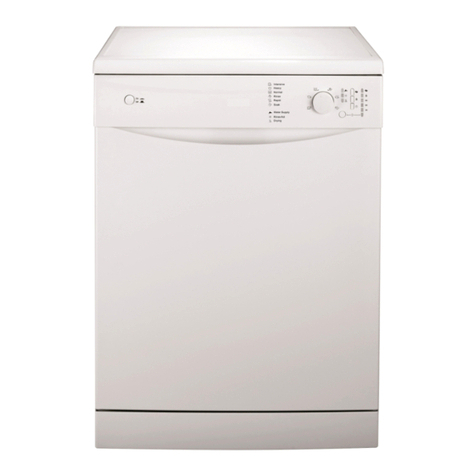
Bellini
Bellini BDW127W Installation instructions

Bellini
Bellini BFDM146X Installation instructions

Bellini
Bellini BDW96W Installation instructions

Bellini
Bellini BDDW605W User manual

Bellini
Bellini BDW96W-F Installation instructions
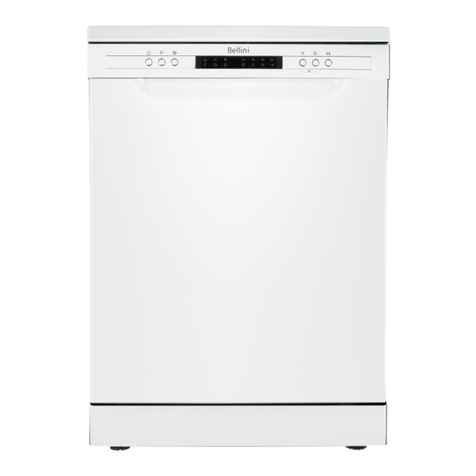
Bellini
Bellini BDWM46W Installation instructions

Bellini
Bellini BDW6WP Installation instructions




